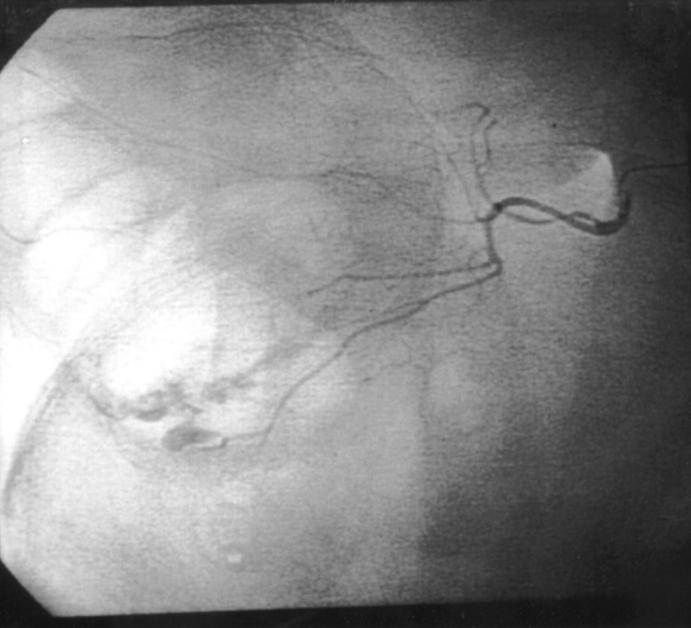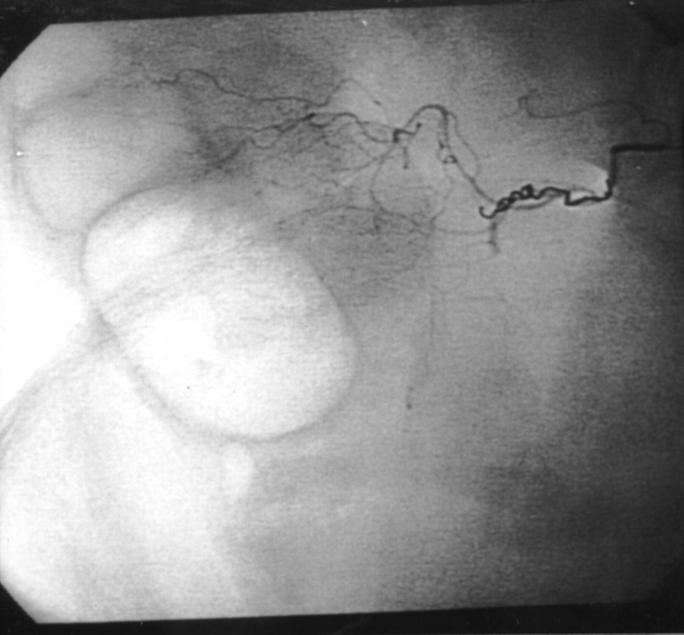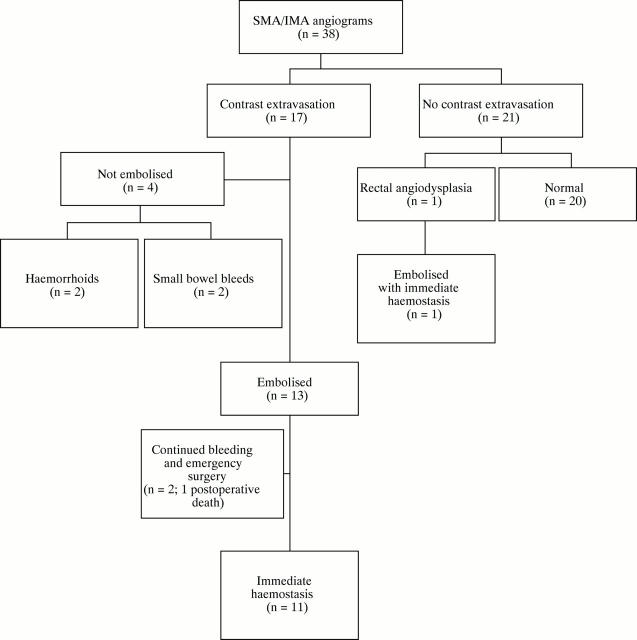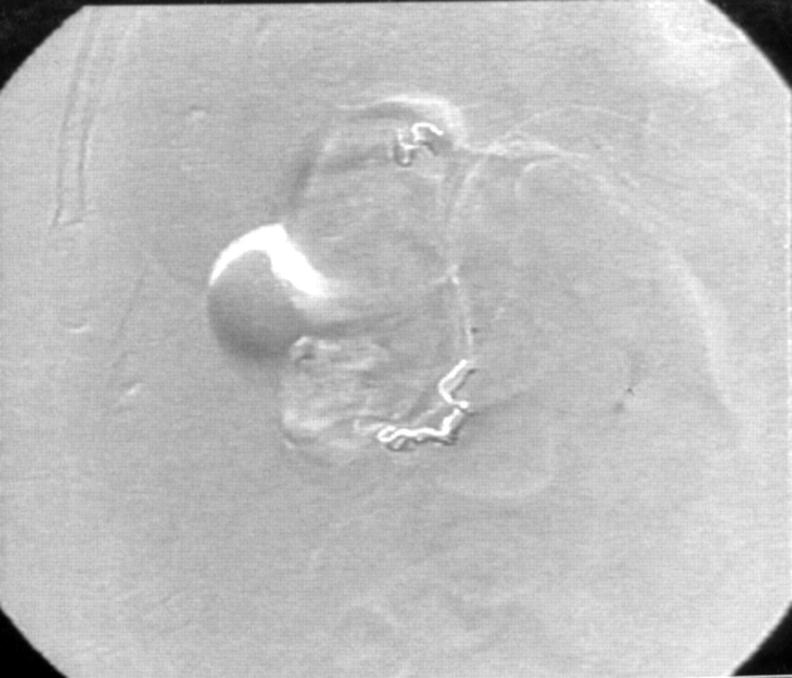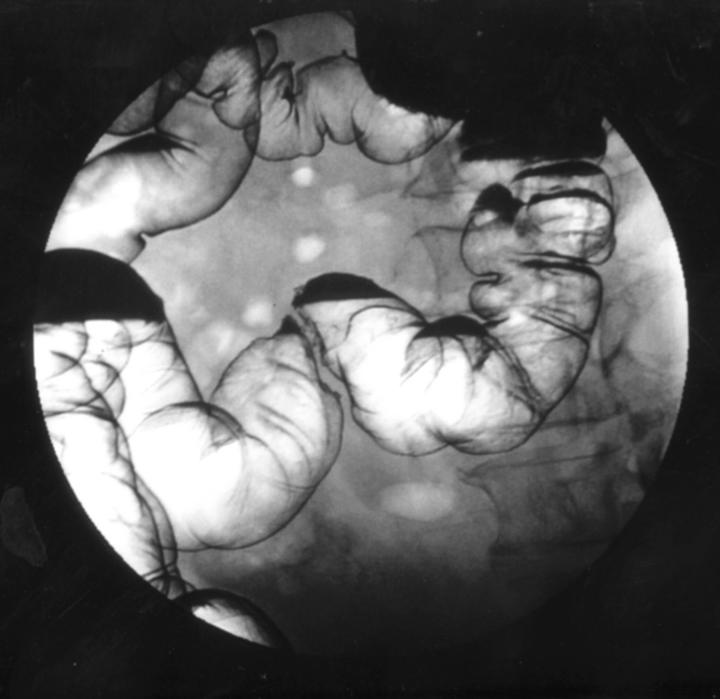Abstract
Background—The management of major colonic bleeding is problematic. A proportion of patients require emergency surgery which is associated with high morbidity and mortality. Percutaneous embolotherapy, previously considered a high risk procedure in the colon, may provide an alternative treatment in this group of patients. Aims—To assess the safety and efficacy of embolotherapy in the treatment of life threatening colonic haemorrhage. Patients and methods—Thirty eight patients with fresh haemorrhage per rectum were referred for surgery because of failed conservative treatment. All underwent angiography; in 14 a bleeding site or vascular abnormality was detected. A coaxial catheter was directed to the most distal bleeding artery and this was embolised with platinum coils. Results—Detection of a bleeding site correlated with haemodynamic stability at the time of angiography (r=1 for a systolic blood pressure less than 100 mm Hg). Bleeding sites or vascular abnormalities were detected and embolised in 14 patients (37%). In 12/14 there was immediate and sustained haemodynamic improvement; two continued to bleed and required emergency hemicolectomy (14%). Three developed ischaemic complications (21.4%); these were managed conservatively and required no intervention. The 30 day mortality was 7.1% in the embolotherapy group and 10.5% in the overall group of 38patients. Conclusion—Colonic embolotherapy for life threatening haemorrhage is an effective, relatively safe procedure with a low incidence of major complications. Its use depends on the identification of a focal bleeding point or vascular abnormality, which in turn depends on the haemodynamic stability of the patient at the time of angiography.
Keywords: colonic haemorrhage; embolisation; angiography; angiodysplasia; diverticular disease
Full Text
The Full Text of this article is available as a PDF (111.9 KB).
Figure 1 .
Digital subtraction angiography of the superior mesenteric artery, with superselective cannulation of a caecal branch of the ileocolic artery, showing haemorrhage into the caecal pole.
Figure 2 .
Introduction of a distal coil resulting in almost instantaneous arrest of haemorrhage.
Figure 3 .
Results of angiography in patients with major colonic haemorrhage, April 1995 to April 1997. SMA, superior mesenteric artery; IMA, inferior mesenteric artery.
Figure 4 .
Angiography indicated bleeding sites at the hepatic flexure and caecal pole. The hepatic flexure coil was placed too close to the marginal artery. Though haemorrhage ceased immediately, an occult ischaemic stricture developed at the site (see fig 5). The caecal pole coils produced immediate haemostasis with no complications.
Figure 5 .
Ischaemic stricture at the hepatic flexure following coil embolisation in the middle colic artery territory (see fig 4).
Selected References
These references are in PubMed. This may not be the complete list of references from this article.
- Allison D. J., Hemingway A. P., Cunningham D. A. Angiography in gastrointestinal bleeding. Lancet. 1982 Jul 3;2(8288):30–33. doi: 10.1016/s0140-6736(82)91162-x. [DOI] [PubMed] [Google Scholar]
- Baum S., Athanasoulis C. A., Waltman A. C. Angiographic diagnosis and control of large-bowel bleeding. Dis Colon Rectum. 1974 Jul-Aug;17(4):447–453. doi: 10.1007/BF02587018. [DOI] [PubMed] [Google Scholar]
- Browder W., Cerise E. J., Litwin M. S. Impact of emergency angiography in massive lower gastrointestinal bleeding. Ann Surg. 1986 Nov;204(5):530–536. doi: 10.1097/00000658-198611000-00004. [DOI] [PMC free article] [PubMed] [Google Scholar]
- Chalmers A. G., Robinson P. J., Chapman A. H. Embolisation in small bowel haemorrhage. Clin Radiol. 1986 Jul;37(4):379–381. doi: 10.1016/s0009-9260(86)80289-6. [DOI] [PubMed] [Google Scholar]
- Clark R. A., Colley D. P., Eggers F. M. Acute arterial gastrointestinal hemorrhage: efficacy of transcatheter control. AJR Am J Roentgenol. 1981 Jun;136(6):1185–1189. doi: 10.2214/ajr.136.6.1185. [DOI] [PubMed] [Google Scholar]
- Fiorito J. J., Brandt L. J., Kozicky O., Grosman I. M., Sprayragen S. The diagnostic yield of superior mesenteric angiography: correlation with the pattern of gastrointestinal bleeding. Am J Gastroenterol. 1989 Aug;84(8):878–881. [PubMed] [Google Scholar]
- Goldberger L. E., Bookstein J. J. Transcatheter embolization for treatment of diverticular hemorrhage. Radiology. 1977 Mar;122(3):613–617. doi: 10.1148/122.3.613. [DOI] [PubMed] [Google Scholar]
- Gomes A. S., Lois J. F., McCoy R. D. Angiographic treatment of gastrointestinal hemorrhage: comparison of vasopressin infusion and embolization. AJR Am J Roentgenol. 1986 May;146(5):1031–1037. doi: 10.2214/ajr.146.5.1031. [DOI] [PubMed] [Google Scholar]
- Kaufman S. L., Martin L. G., Zuckerman A. M., Koch S. R., Silverstein M. I., Barton J. W. Peripheral transcatheter embolization with platinum microcoils. Radiology. 1992 Aug;184(2):369–372. doi: 10.1148/radiology.184.2.1620829. [DOI] [PubMed] [Google Scholar]
- Last M. D., Lavery I. C. Major hemorrhage and perforation due to a solitary cecal ulcer in a patient with end-stage renal failure. Dis Colon Rectum. 1983 Aug;26(8):495–498. doi: 10.1007/BF02563737. [DOI] [PubMed] [Google Scholar]
- Lawler G., Bircher M., Spencer J., Hemingway A. P., Allison D. J. Embolisation in colonic bleeding. Br J Radiol. 1985 Jan;58(685):83–84. doi: 10.1259/0007-1285-58-685-83. [DOI] [PubMed] [Google Scholar]
- Leitman I. M., Paull D. E., Shires G. T., 3rd Evaluation and management of massive lower gastrointestinal hemorrhage. Ann Surg. 1989 Feb;209(2):175–180. doi: 10.1097/00000658-198902000-00007. [DOI] [PMC free article] [PubMed] [Google Scholar]
- Matolo N. M., Link D. P. Selective embolization for control of gastrointestinal hemorrhage. Am J Surg. 1979 Dec;138(6):840–844. doi: 10.1016/0002-9610(79)90308-8. [DOI] [PubMed] [Google Scholar]
- Mitty H. A., Efremidis S., Keller R. J. Colonic stricture after transcatheter embolization for diverticular bleeding. AJR Am J Roentgenol. 1979 Sep;133(3):519–521. doi: 10.2214/ajr.133.3.519. [DOI] [PubMed] [Google Scholar]
- Newton T. H., Adams J. E. Angiographic demonstration and nonsurgical embolization of spinal cord angioma. Radiology. 1968 Nov;91(5):873–passim. doi: 10.1148/91.5.873. [DOI] [PubMed] [Google Scholar]
- O'Halpin D., Legge D., MacErlean D. P. Therapeutic arterial embolisation: report of five years' experience. Clin Radiol. 1984 Mar;35(2):85–93. doi: 10.1016/s0009-9260(84)80001-x. [DOI] [PubMed] [Google Scholar]
- Rahn N. H., 3rd, Tishler J. M., Han S. Y., Russinovich N. A. Diagnostic and interventional angiography in acute gastrointestinal hemorrhage. Radiology. 1982 May;143(2):361–366. doi: 10.1148/radiology.143.2.6978500. [DOI] [PubMed] [Google Scholar]
- Richards W. O., Grove-Mahoney D., Williams L. F. Hemorrhage from a Dieulafoy type ulcer of the colon: a new cause of lower gastrointestinal bleeding. Am Surg. 1988 Feb;54(2):121–124. [PubMed] [Google Scholar]
- Rosenkrantz H., Bookstein J. J., Rosen R. J., Goff W. B., 2nd, Healy J. F. Postembolic colonic infarction. Radiology. 1982 Jan;142(1):47–51. doi: 10.1148/radiology.142.1.6975953. [DOI] [PubMed] [Google Scholar]
- Sherman L. M., Shenoy S. S., Cerra F. B. Selective intra-arterial vasopressin: clinical efficacy and complications. Ann Surg. 1979 Mar;189(3):298–302. doi: 10.1097/00000658-197903000-00007. [DOI] [PMC free article] [PubMed] [Google Scholar]
- Sniderman K. W., Franklin J., Jr, Sos T. A. Successful transcatheter Gelfoam embolization of a bleeding cecal vascular ectasia. AJR Am J Roentgenol. 1978 Jul;131(1):157–159. doi: 10.2214/ajr.131.1.157. [DOI] [PubMed] [Google Scholar]
- Spencer J. Lower gastrointestinal bleeding. Br J Surg. 1989 Jan;76(1):3–4. doi: 10.1002/bjs.1800760103. [DOI] [PubMed] [Google Scholar]
- Spiller R. C., Parkins R. A. Recurrent gastrointestinal bleeding of obscure origin: report of 17 cases and a guide to logical management. Br J Surg. 1983 Aug;70(8):489–493. doi: 10.1002/bjs.1800700812. [DOI] [PubMed] [Google Scholar]
- Whitaker S. C., Gregson R. H. The role of angiography in the investigation of acute or chronic gastrointestinal haemorrhage. Clin Radiol. 1993 Jun;47(6):382–388. doi: 10.1016/s0009-9260(05)81057-8. [DOI] [PubMed] [Google Scholar]



